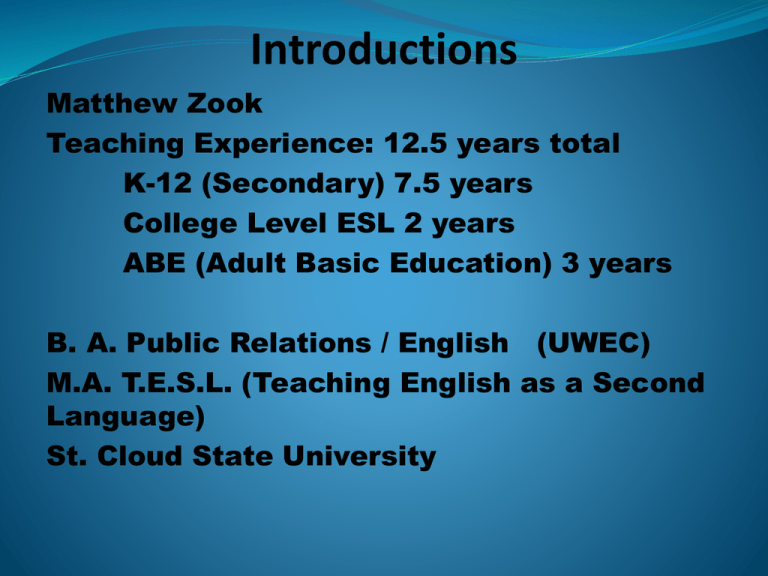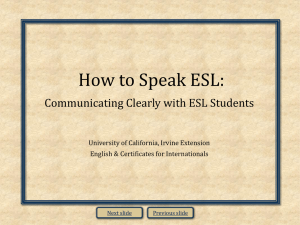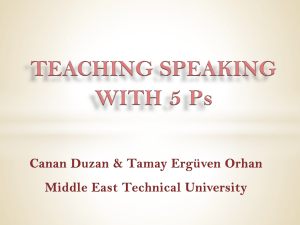PPT - MinneTESOL
advertisement

Introductions Matthew Zook Teaching Experience: 12.5 years total K-12 (Secondary) 7.5 years College Level ESL 2 years ABE (Adult Basic Education) 3 years B. A. Public Relations / English (UWEC) M.A. T.E.S.L. (Teaching English as a Second Language) St. Cloud State University Improving Phonemic Awareness in ESL Pronunciation Using Shadowing During Tutorials: Implications for ESL Teachers by: Matthew Zook Thesis Outline 1. Motivation & purpose for study 2. Research questions 3. Literature review 4. Methodology 5. Results 6. Discussion & Concluding Remarks 7. References Motivation for study The motivation to perform this study stems from personal experience working as an ESL tutor/Instructor at St. Cloud State University and as an ABE Instructor at the St. Cloud Technical & Community College. Knowing to a degree, which features ESL students have trouble with in terms of pronunciation can strengthen ESL pedagogy and lead to improvements in overall English proficiency. Motivation: Continued The goal of this research was to provide evidence for the reformation of pronunciation pedagogy. If students can become more attentive to the types of phonemic errors they make, perhaps their overall oral language use will improve. They could become more confident and efficient speakers. Purpose of study The present study sought to focus specifically on the intermediate ESL learner’s processes of oral production and whether speech reproduction tasks such as shadowing can lead to the development of phonemic awareness. The research proposes that the use of a modified tutorial technique called shadowing will allow ESL students’ oral language usage to improve in terms of producing fewer phonemic errors in pronunciation. Empirical Research A. Cohen (1980), based his study on the shadowing of texts containing phonological and lexical speech errors. According to Cohen (1980), he demonstrated that the word itself is the monitoring unit for the first kind of errors and that subjects tend to overhear phonological errors more readily than lexical ones. Cohen Study: Findings Monitoring one’s own or an interlocutor’s speech may thus provide the speaker with structural constraints to be implemented on the next utterance, be it a repair, a conjunct, or an answer. By transferring and reusing structural properties of previous speech the speaker may at the same time gain in fluency, and establish discourse coherence to the advantage of the listener. Cohen, A. (1980): Correcting of speech errors in a shadowing task”, in V.A. Fromkin (ed.), Errors in linguistic performance. Slips of the tongue, ear, pen and hand, New York, Academic Press, pp. 157-63. Goals of Presentation The main thing I aim to do is to leave you with a few things you will find useful, practical, and applicable in your everyday classrooms. I want to show you that shadowing can be used as a pedagogical instrument. To Accomplish this I will… 1. To give you some specific tools you can use in your classrooms. 2. Give you practical ideas that you can apply to the lessons you teach. 3. Show you how shadowing works (video clips) Thesis Research Purpose The present research sought to examine three speech samples from ESL students: spontaneous, rehearsed, and read-aloud and to provide an analysis that would determine if the usage of shadowing as a pedagogical tool would lead to an increased level of phonemic awareness in ESL students. Thesis Research Purpose: Continued In order to accomplish its objectives, the present study seeks to first discuss the background for the basis of the current research. Second, to provide an explanation of key terms central to the research study and provide data analysis to illustrate whether research questions were answered, and finally, to provide implications to ESL teachers and implications for further study. Research Questions 1-4 1. Will phonemic awareness improve over time? (N = 10) 2. Does listener attitude due to gender affect perceptions of information and therefore influence reproduction of a speaking event? Do participants’ scores differ between genders? 3. Do participants phonemic awareness score’s differ based on native language? 4. Does the use of a transcript influence the degree of change in phonemic awareness as opposed to not using a transcript? A. Background B. Shadowing explained C. Terminology - Fluency vs. Accuracy D. Case for Improvement E. Tutorial Approach - Personal experiences Literature Review: Background The background for conducting research comes as a result of recent trends in education. Current research states that the number of nonnative speakers of English immigrating to the United States is increasing. Wong and Morley (1987, 1988) identified a number of groups whose pronunciation difficulties could put them at a social disadvantage. Literature Review: Background Those groups include immigrant residents who have passed into the workplace, adult and teenage refugees in vocational and language training programs attempting to learn survival language skills, and foreign exchange students who wish to enter English-speaking colleges and universities to pursue an undergraduate and/or graduate degree. Shadowing Types: Examples SEE PAPER HAND-OUT Shadowing Types According to Murphey there are three main types of shadowing: complete, selective, and interactive. Moreover, complete shadowing refers to listeners shadowing everything speakers say during a conversation. Selective shadowing refers to listeners selecting specific words and/or phrases to shadow. Third, Interactive shadowing allows for questions to be added into the conversation by the listener. To illustrate Murphey gives an example of each type: Literature Review: Terminology Automaticity: Pronunciation assessment is a key component of the current research study. Pronunciation can be assessed using a variety of methods in a variety ways. A common way it is assessed is in terms of a concept called automaticity. Webster’s Dictionary defines automaticity as the ability to do things without occupying the mind with the low-level details required, allowing it to become an automatic response pattern or habit. Literature Review: Fluency Elizabeth Gatbonton and Norman Segalowitz (1988) view the previously mentioned term automaticity as a component of fluency. In considering fluency, one can broadly distinguish between skills concerned with the selection of utterances (knowing what to say, to whom and when) and skills concerned with the actual production of these utterances (producing them rapidly and smoothly, without hesitations and pauses). (p. 473) Literature Review: Fluency In regards to proficiency training Neri et al. state “Consequently, optimal and realistic pronunciation training must not only be geared towards effective and efficient communication, it must also be time-effective, focusing on pronunciation aspects that appear to be most problematic for a large group of learners of a given L2” (p. 358). Literature Review: Accuracy In a paper by Hall (1997), he makes a number of important points concerning phonological accuracy . In the process, he presents a case for the application of pronunciation development to ESL learners. He states that a major difference between fluency and accuracy is that the importance of sound accuracy continues to be prevalent in today’s classrooms. Literature Review: Accuracy Hall (1997) explains by stating “The need to focus on being accurate with sound has always remained while the emphases on pronunciation have differed with attention to fluency development through communicative speaking tasks.” Hall (1997) says there should be a balance in how much attention is paid to each while being discussed in the classroom. Literature Review: Improvement This brief overview of existing literature reveals that although research on second-language phonological instruction is in its infancy, there is interest in determining whether we can effectively teach pronunciation. Yen-Shou Lai et al., 2009, p. 267). “many researchers indicate that native language pronunciation significantly affects the learning of English pronunciation. EFL learners can easily make mistakes while they sound English words” “The reason for this is that the phonetic sound systems of their native language are different from the phonetic sound systems in the English language” As an ESL and ABE Instructor I have had personal experience with this particular issue. (anecdote here) Literature Review: Improvement Pronunciation differences between native language speakers and ESL learners can be summarized as follows according to Jenkins, (2000) and Wang (2003): a. Lack: Sounds of some English words do not exist. Therefore, learners are not able to correctly pronounce the words. (personal example) b. Substitution: Learners substituted English pronunciation with similar native language; this may cause incorrect pronunciation for syllable, intonation, and rhyme. (personal example) Literature Review: Tutorials A brief overview of the benefits: A. Allows for focus and flexibility to work on identified and desired areas of need. B. Harris and Silva (1993) discuss the importance of being able to identify patterns of pronunciation problems in students. This could serve as an effective tool for teachers because if used properly, it could lead to greater increases in language usage, monitoring, and repair as a result of developing an increased sense of phonemic awareness. Tutorial Benefits One of the best things about the use of shadowing during tutorials from an educator’s perspective is that the teacher gets to monitor the student’s progress by taking notes. This allows for both teacher & student to discuss specific sounds the student is struggling with. For example, I took note of the phonological sounds my students were having trouble pronouncing correctly like: <l> & <r>(liquids), <f> & <v>(fricatives), <p>, <b>(stops), <-th>(voiced) & <-th>(unvoiced) (fricatives). A. Participants B. Speech Raters C. Procedure: 1. Speech Tasks and Timeline 2. Shadowing 3. Inter-Rater Reliability Methodology: Participants Demographics: A. Ages 19-22 B. Sample size = Six male and four female C. Countries of origin: China, Japan, Iraq, Saudi Arabia. D. ESL students seeking entrance into regular education classes at SCSU Methodology: Speech Raters Demographics: A. Sample size = Four adults B. Two females and two males C. Two raters (1 female & 1 male) = Current ESL Instructors D. Two raters (1 female & 1 male) = Former collegelevel professors of history and English literature E. Age ranges = 31-65 31= Youngest (f) 65= Oldest (m) Methodology: Procedure -Speech Tasks Timeline 1. Week 1: Pre-tests A. Spontaneous = Describe picture B. Rehearsed = Describe picture with 5 minutes of prep time (notes) C. Read aloud 2. Weeks 2-10: Shadowing practice attempts 3. Week 11: Post-tests (Same as 1 above) Methodology: Procedure -Shadowing The participants were tasked with shadowing three text recordings (NY Times and Pro-Lingua workbook) per week for a total of 20-25 minutes. Each shadowing session consisted of first listening to the auditory target text (recorded readings of newspaper articles by native English speakers). Second, after the first listening, each participant was asked to attempt to shadow each pre-recorded auditory text. During each tutorial session, the students shadowed a total of three auditory texts. Methodology: Procedure -Shadowing It is important to note that only Student Group A was allowed to view a written transcript during the first listening to the auditory input used for each shadowing attempt. Methodology: Procedure -Inter-Rater Reliability Inter-rater reliability: It was hypothesized that the current teachers would give higher average scores than the former teachers. This also proved to be apparent as a result of the data analyzed. Therefore, to increase the chances of making the results of the hypotheses tests discussed later in chapter four statistically significant, the average mean scores of the speech sample raters were adjusted to be at a consistency of 2.45. Please refer to Table I. Table 1 Table I: Inter-Rater Reliability Tj=9.8/4= 2.45 Adjustments to J’s scores because of experience Judge Average differences (2) J1 44/15 (2.93) -.48 (2) J2 38/15 (2.53) -.08 (1) J4 37/15 (2.47) -.02 (1) J3 28/15 (1.87) +.58 Notes: T=total, j=judge (1)=former teacher, (2)=Current teacher J1=Youngest and J3=Oldest A. Answers to research questions 1-4 B. Explanation of findings and charts Results: Research Question 1 1. Will oral language proficiency improve over time? (N = 10) According to the data, the answer is no. The results illustrate that there was no statistically significant improvement in oral language even after the adjustment to judges 1-4 was made. See table II. *Experimental section of data in which the student sample size was manipulated to be 30 (N=30) and that yielded no statistically significant results. Results: Research Question 2 2. Do participants’ scores differ between genders? According to the data, there were no statistically significant differences in oral language proficiency scores between genders (male & female). Results: Research Question 3 RQ3: Do participants score’s differ based on native language? A one way analysis of variance (ANOVA) was used to assess differences between participants’ native language on spontaneous, rehearsed, and read aloud pre-test scores and spontaneous, rehearsed, and read aloud post-test scores. For all analyses, there were no significant differences between Language 1(Chinese), Language 2(Arabic), and Language 3(Japanese). Results: Research Question 4 RQ4: Does receiving a transcript influence degree of change? An individual samples T-test was conducted comparing groups A and B on the degree of change in scores from pre-test to post-test. Degree of change was computed by subtracting pre-test scores from post-test scores. Group A used a written transcript while performing the shadowing oral language tasks. Group B did not use a written transcript while performing the shadowing oral language tasks. There were no significant differences on degree of change in spontaneous scores, change in rehearsed scores, or change in read aloud scores. Results: Analyses Summary In terms of RQ1, the Null hypothesis was retained but the Alternative hypothesis was not (m1 did not equal m2). In the case of RQ2, again, the Null hypothesis was retained but the Alternative hypothesis was not because there were no scores less than or equal to Alpha 0.05. For RQ3, the Null hypothesis was retained but the Alternative hypothesis was not. Finally, for RQ4, the Null hypothesis was retained but the Alternative hypothesis was not. Discussion: Outline A. Goals B. Pedagogical Implications (ESL Teachers) C. Limitations D. Further Research Suggestions Discussion: Goals The present study examined the effects of shadowing tasks of college-level ESL students to see if it would lead to improvements in oral language usage. Two primary goals were the basis for the collection of the data. The first goal was to develop a base of knowledge about college-level ESL students’ levels of English language use. The second was to determine whether the implementation of shadowing tasks had any positive effects on college-level ESL students in terms of it leading to an increase in phonemic awareness. Discussion: Pedagogical Implications Marc Lewis, from the University of Cincinnati, attempted to determine whether shadowing unlocked or locked attention towards an auditory message. The results were that it unlocked students’ attention towards auditory messages. According to Lewis, “While shadowing is known to have a detrimental effect on the subject’s attending to the content of a non-shadowed message, its effect on the shadowed message is unknown” (Lewis, 1975, p. 455). Pedagogical Implications Lewis, 1975, p. 455 While this study did not confirm Lewis’ insights, teachers and tutors may want to consider the issue of increasing the amount of practice done during class time to prove whether the preceding scenario holds true. Discussion: Implications: Continued Fluency, accuracy, and automaticity. Research by Peter Robinson (1997) According to a study by Peter Robinson, the debate continues to grow on whether learning under conditions with a focus on form is more important than learning under conditions in which it is not important. According to Robinson, “the development of automaticity in learning occurs as a function of exposure to multiple instances of input” (Robinson, 1997, p. 224). Discussion: Pedagogical Implications A Question to Consider: For teachers and tutors alike, the scenarios presented earlier come with a few challenges. For example, how to serve an entire class, what areas of form should the students focus on and what about access to one-to-one lessons and lab time? Pedagogical Implications Teachers could differentiate instruction with shadowing A. Beginning or low level = Use sentences with target words. B. Mid-level to higher level = Use short paragraphs or selected pages from elementary-age books. C. High level to Advanced = Use articles from newspapers & / or magazines. (NY Times, Star Tribune, Time, Newsweek, etc.) Discussion: Limitations Limitations of my research study: Sample size Limited time of study (cross categorical) Absence of control group Judge rater reliability (adjustment was made) (more judge training needed) Discussion: Further Suggestions • Make study longitudinal (over 1.0-1.5 yr. period) • Bigger sample size would increase reliability of data • Do something to account for inter-rater reliability Offer more extensive training. • Psychological factors could include such things as; motivation, shyness, confidence, and other cultural barriers that could affect the participants’ comfort level. If a participant is uncomfortable, perhaps that would have an impact on his or her scores? Discussion: Further Suggestions Gauge the participants’ sense of their ability to use pronunciation before the shadowing study . Perhaps researcher could record individual shadowing events and playback. This would benefit both student and instructor. Consider the appropriateness of the texts being shadowed by the participants. Concluding Remarks According to the results of this study, it is not certain that students would improve their oral language proficiency by increasing their phonological awareness. Therefore, it should be noted that further research is needed to determine if the usage of shadowing during tutorial sessions leads to increased oral language proficiency. References Acton, W. (1984). Changing fossilized pronunciation. TESOL Quarterly, 18(1), pp. 71-85. Baker, F. M. (1928). Pronunciation analysis. The French Review, 1(3), pp. 37-43. Carrell, P. L. (1987). Content and formal schemata in ESL reading. TESOL Quarterly, 21(3), pp. 461-481. Chan, A. Y. W. (2004). Syntactic transfer: Evidence from the interlanguage of Hong Kong Chinese ESL learners. The Modern Language Journal, 88(1), pp. 56-74. Derwing, T. M., Munro, M. J., & Thomson, R. I. (2008). A longitudinal study of ESL learners' fluency and comprehensibility development. Applied Linguistics, 29(3), 359-380. doi:10.1093/applin/amm041 References Elliott, A. R. (1997). On the teaching and acquisition of pronunciation within a communicative approach. Hispania, 80(1), pp. 95-108. Esling, J. H., & Wong, R. F. (1983). Voice quality settings and the teaching of pronunciation. TESOL Quarterly, 17(1), pp. 89-95. Flores, C. (2010). The effect of age on language attrition: Evidence from bilingual returnees. Bilingualism: Language and Cognition, 13(4), 533-546. Hauck, M., & Haezewindt, B. (1999). Adding a new perspective to distance (language) learning and teaching–the tutor’s perspective. ReCALL, 11(2), 46-54. Illinois Univ., Urbana. Div. of English as an International Language. (1993). Issues and developments in english and applied linguistics (IDEAL). 1989-1993. Issues and Developments in English and Applied Linguistics (IDEAL), 4-6 References Jiang, N. (2004). Semantic transfer and its implications for vocabulary teaching in a second language. The Modern Language Journal, 88(3), pp. 416-432. Kang, O. (2010). Relative salience of suprasegmental features on judgments of L2 comprehensibility and accentedness. System, 38(2), 301-315. doi:DOI: 10.1016/j.system.2010.01.005 Kappes, J., Baumgaertner, A., Peschke, C., & Ziegler, W. (2009). Unintended imitation in nonword repetition. Brain and language, 111(3), 140-151. Leahy, R. M. (1980). A practical approach for teaching ESL pronunciation base on distinctive feature analysis. TESOL Quarterly, 14(2), pp. 209-219. Lee, L. (2000). Evaluating intermediate Spanish students' speaking skills through a taped test: A pilot study. Hispania, 83(1), pp. 127-138. References Lewis, M., Honeck, R. P., & Fishbein, H. (1975). Does shadowing differentially unlock attention? The American Journal of Psychology, 88(3), 455-458. Lord, G. (2005). (How) can we teach foreign language pronunciation? on the effects of a Spanish phonetics course. Hispania, 88(3), pp. 557567. Major, R. C. (2010). First language attrition in foreign accent perception. International Journal of Bilingualism, 14(2), 163-183. doi:10.1177/1367006910363063 Molholt, G. (1990). Spectrographic analysis and patterns in pronunciation. Computers and the Humanities, 24(1/2, Selected Papers from the Duluth Conference on Computers and Writing, and Language Instruction), pp. 81-92. Morley, J. (1991). The pronunciation component in teaching english to speakers of other languages. TESOL Quarterly, 25(3), pp. 481-520. References Murphy, J. M. (1991). Oral communication in TESOL: Integrating speaking, listening, and pronunciation. TESOL Quarterly, 25(1), pp. 51-75. Nakatani, Y. (2010). Identifying strategies that facilitate EFL learners' oral communication: A classroom study using multiple data collection procedures. The Modern Language Journal, 94(1), 116-136. Oral Proficiency Guidelines. (n.d.) Retrieved from http://www.pmsd.org/LinkClick.aspx?fileticket=wSiCTdOj29g%3D &tabid=730&mid=1394 Parish, C. (1977). A practical philosophy of pronunciation. TESOL Quarterly, 11(3), pp. 311-317. Pennington, M. C., & Richards, J. C. (1986). Pronunciation revisited. TESOL Quarterly, 20(2), pp. 207-225. References Pica, T. (1984). L1 transfer and L2 complexity as factors in syllabus design. TESOL Quarterly, 18(4), pp. 689-704. Robinson, P. (1997). Generalizability and automaticity of second language learning under implicit, incidental, enhanced, and instructed conditions. Studies in second language acquisition, 19(02), 223-247. Sanchez, K., Miller, R. M., & Rosenblum, L. D. (2010). Visual influences on alignment to voice onset time. Journal of Speech, Language & Hearing Research, 53(2), 262-272. Slowiaczek, L. M. (1994). Semantic priming in a single-word shadowing task. The American Journal of Psychology, 107(2), 245260. Tarone, E. (1972). Interlingual identification in pronunciation. TESOL Quarterly, 6(4), pp. 325-331. References Wang, Y., Martin, M. A., Martin, S. H., & Martin, S. (2002). Understanding asian graduate students' english literacy problems. College Teaching, 50(3), 97-101. Wipf, J. A. (1985). Towards improving second-language pronunciation. Die Unterrichtspraxis / Teaching German, 18(1), pp. 55-63. Yen-Shou Lai, Hung-Hsu Tsai, & Pao-Ta Yu. (2009). A multimedia english learning system using HMMs to improve phonemic awareness for english learning. Journal of Educational Technology & Society, 12(3), 266-281. Questions/Comments? Matthew Zook 608-216-4888 matthew.zook@isd742.org THANK YOU FOR YOUR TIME






